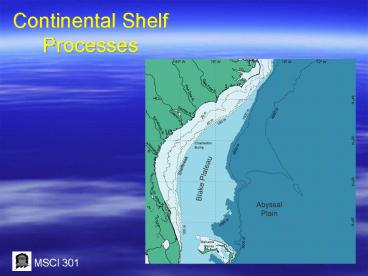Continental Shelf Processes - PowerPoint PPT Presentation
1 / 31
Title:
Continental Shelf Processes
Description:
South Atlantic Bight (Chen) MSCI 301. South Atlantic. Bight Tidal. Currents (Chen) Typically range from 0 20 cm/s on the continental shelf ... – PowerPoint PPT presentation
Number of Views:447
Avg rating:3.0/5.0
Title: Continental Shelf Processes
1
Continental Shelf Processes
2
Areas on the shelf
- Inner shelf 0 - 20m depth
- Middle shelf 20 - 40m depth
- Outer shelf 40m Shelfbreak (100m)
- US East Coast Wide, gently sloped shelves.
Varies from in width from 30 miles at Cape
Hatteras to 100 miles wide in Georgia. - US West Coast Narrow, steep shelves.
- Width is approx. 25 30 miles.
3
Physical Processes
4
Sources of Currents on Continental Shelves
- Waves
- High frequency oscillatory currents (T 3-30
seconds) - Infragravity waves - wave groups (T 30 5
minutes) - Tides
- Inlet Mouth Currents
- Rotary Continental Shelf Flow
- Wind
- Ekman Transport
- Wind-driven along-shelf currents
- Permanent (Recurring) Currents
- Gulf Stream Intrusions
5
Atlantic Coast - wave and tidal climate
6
Gulf of Mexico wave and tidal climate
7
Pacific Coast wave and tidal climate
8
WINDS
- SEASONAL VARIABILITY
- Summers Bermuda High over Atlantic resulting in
dominant southerly winds - Winter dry, cold air mass over N. American
continent northerly winds with strong southerly
winds due to advancing frontal systems - Spring and fall transitional months
intermittent strong northerly winds - SYNOPTIC VARIABILTY
- Frontal systems 2 7 days (winter)
9
Wind climatology
Spring
Summer
Winter
Fall
10
Wind-driven Currents
- Winds typically need to have a duration of over
36 hours to generate wind-driven currents on the
shelf. - Low-frequency currents that can overwhelm tidal
cycle (period gt24 hours) . - Across-shelf currents are due to wind set-up due
to on-shore winds. - Along-shelf currents move parallel to the coast
11
Tides on Continental Shelves
- Usually A Progressive Wave Along the Coast
- Amplified Height in Continental Embayments
- Georgia Embayment 8, Cape Hatteras 3.6
- Generates Rotary Water Motion - Tidal Current
- Like Elliptical Water Motion in a Shallow Water
Wave - Continues as a Wave Up Estuaries and Rivers
- Conway is 8 Hours After Ocean
12
(No Transcript)
13
South Atlantic Bight
(Chen)
14
South Atlantic Bight Tidal Currents
- Typically range from 0 20 cm/s on the
continental shelf - Increase closer to the coast
- Rotate clockwise in an elliptical shape on the
shelf (tidal ellipse)
(Chen)
15
Waves on Continental Shelves
- Transitional waves
- 1/20 lt D/L lt ½
- Shallow water waves
- D/L lt 1/20
16
Wave DissipationWave heights decrease as waves
traverse the shelf towards the coast.
d 30m
d 15m
17
Wave Energy Dissipation
- Energy of waves is dissipated due to bottom
friction from the seafloor as waves traverse the
continental shelf. - E1/8(density)(g)H2
- Shallow wide shelf more energy dissipated
smaller waves along the coast
18
How do we measure physical processes on the
continental shelf?
- NOAA Integrated Ocean Observing System
- In-situ measurements from buoys and mooring
stations. - Sampling cruises
19
Physical oceanographic instrumentation
20
(No Transcript)
21
Acoustic Doppler Current Profiler
22
(No Transcript)
23
(No Transcript)
24
Waves across the shelf
- Waves create high shear on the seafloor and
result in sediment resuspension and bio erosion
of hardbottom habitats. - As the depth of the shelf decreases, waves effect
the seabed more creating larger shear stresses. - More sediment transport on inner-shelf and
nearshore regions - Hardbottom habitats can be broken down and
transported during storms
25
Hydrodynamics in the bottom boundary layer
2 bottom boundary layers
- Slowly varying currents develop a thick bbl
where shear stresses are relatively small - Thin wave bbl creates high shear stresses
- These two interact non-linearly creating high
combined w-c shear stresses
Current
1-10 m
wave
mm
Suspended sediment transport Bedload sediment
transport
Seabed
26
Bottom Boundary Layer Processes
27
Bottom boundary layer processes - Why is the
bottom boundary layer of the ocean important?
The oceanographic processes that occur within a
few meters of the bed can have a wide-scale
impact on processes that occur throughout the
continental shelf. This is primarily due to two
main factors 1) the bottom boundary layer
serves as a transition region for the exchange of
nutrients, chemicals, and biota between the
overlying water column and the seabed 2) the
bottom boundary layer is a source of turbulent
kinetic energy and strong dissipative shear
stresses.
28
River Plume Processes
- Nutrients
- Turbidity
- Freshwater
29
(No Transcript)
30
Model of River Runoff
Which way is the water flowing after leaving the
mouth?
(Chen)
Buoyant Coastal Current
31
Gulf Stream Effects
- Gulf Stream runs along edge of continental shelf
- Topographical upwelling
- Charleston Bump
- Eddies and filaments intrude onto the shelf































